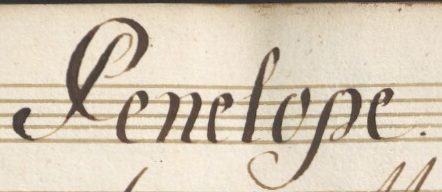Sources
No autograph of Penelope has survived, as with most of F. B. Conti’s operas. Several copies of the score and parts for the strings have been preserved from the immediate context of its composition at the Viennese court, while the parts for the wind instruments were destroyed. Violin I is the part for the concertmaster, who conducted the performance from the instrument together with the chapel master. The continuo is therefore also notated in his part for reference. The part for the violoncello only contains the arias, i.e. it is a ripieno part, whereas the solo part with the recitatives was not preserved, nor was the part for the double bass.

The following sources are preserved in the music collection of the Austrian National Library:
A-Wn Mus.Hs. 17110/1–3 and A-Wn Mus.Hs. 17226/1–3 score copies
A-Wn Mus.Hs. 17227/1–4 parts for violin I (for the concertmaster, including the bass part), violin II, viola, violoncello (only for ripieno, i.e. without the recitatives)
A-Wn Mus.Hs. 17051/1.3–5, no. 12: aria Ulisse "S'io credo"
A further score copy is preserved in the archive of the Gesellschaft der Musikfreunde in Vienna: A-Wgm IV 1973 (Q 1280).
Prince Anton Ulrich of Saxe-Coburg-Meiningen also ordered a copy of the score for his music collection; one of the exemplars from the Vienna court chapel usually served as a source. It is a pure reception source, as a performance in Meiningen was not intended and the score served only as an artefact for the collection. D-MEIr Ed 119o (RISM entry).
Another copy from the late 18th century (between ca. 1780 and 1800) was formerly in the archives of the Gesellschaft der Musikfreunde and is now housed in the Bibliothèque nationale in Paris: F-Pn D-2339 (see RISM entry; catalogue record of the Bibliothèque nationale).
RISM lists also an score copy made by Wilhelm Kupfer in 1911, now in the Library of Congress, Washington: US-Wc M1500.C7 P3

Further important sources are the original printed libretto in Italian, and a German translation; for the edition, we used the digital copies in the Herzog August Bibliothek Wolfenbüttel and the Schatz Collection in the Library of Congress .
A report about the performance with a short summary of the plot, taken from the German libretto print, can be found in the Wienerisches Diarium nr. 14, 16. February 1724, [p. 7]. Supplementary information about the presence of the emperor at the rehearsals are noted in the ceremonial protocols (Vienna, Haus-, Hof- und Staatsarchiv, Obersthofmeisteramt, Hofzeremonielldepartement, Zeremonialprotokolle 12, 1723–1724, 278r–285).




